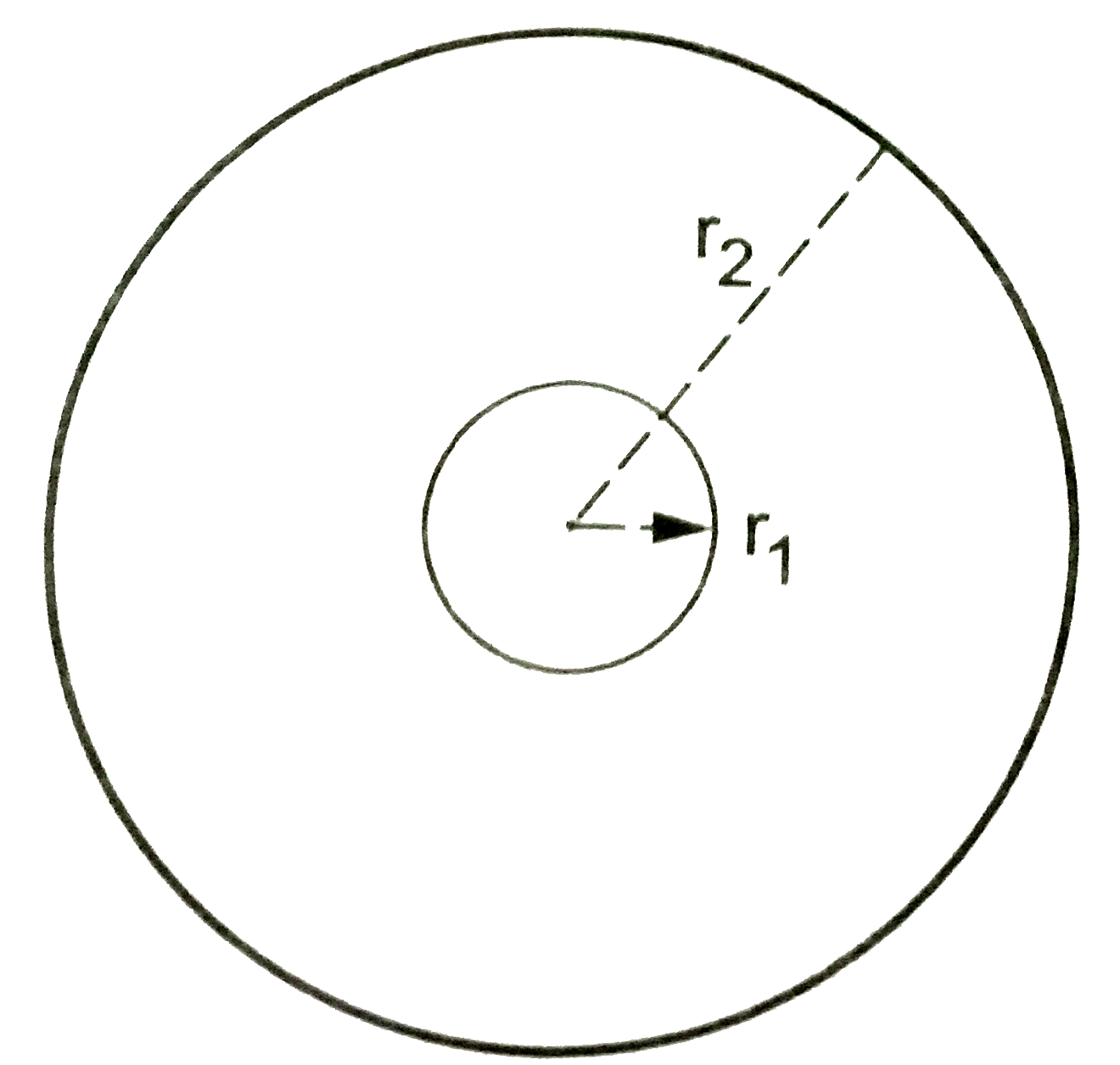दो संकेद्रीय (concentric ) वृत्ताकार कुंडलियाँ समाक्षीय रुप से (coaxially) व्यवस्थित हैं । इनकी त्रिज्याएँ r1 तथा (r2 हैं तथा r1≤≤r2 हैं । इस अवस्था का अन्योन्य प्रेरकत्व (mutual inductance) ज्ञात करें ।

The correct Answer is:μ0πr212r2
बड़ी कुंडली से I धारा प्रवाहित करने पर इसके केंद्र पर चुंबकीय क्षेत्र B=μ0I2r2 , तथा केंद्र पर स्थित कुंडली से संबध्द चुंबकीय फ्लक्स ϕ=BA=μ0I2r2(πr21)=μ0πr21I2r2.
अतः समीकरण ϕ2=MI1 से , ϕ=MIयाμ0πr21I2r2=MI,∴M=μ0πr212r2
Topper's Solved these Questions
- BOOK - BHARATI BHAWANCHAPTER - विद्युत - चुंबकीय प्रेरणEXERCISE - प्रश्नावली (दीर्घ उत्तरीय प्रश्न )8videos
विद्युत - चुंबकीय प्रेरण
- BOOK - BHARATI BHAWANCHAPTER - विद्युत - आवेश तथा कुलोम का नियम EXERCISE - उदाहरण13videos
विद्युत - आवेश तथा कुलोम का नियम
- BOOK - BHARATI BHAWANCHAPTER - विद्युत - परिपथ तथा किर्कहॉफ के नियम EXERCISE - आंकिक प्रश्न33videos
विद्युत - परिपथ तथा किर्कहॉफ के नियम
Similar Questions
प्रेरित धाराएँ क्या हैं ? इनकी उत्पत्ति को दिखाने के लिए दो प्रयोगों का वर्णन करें ।
05:35View Solutionकुचालक पदार्थ से बने दो गोलों को एक-दूसरे से रंगड़कर 1cm की दूरी पर रखा जाता है। यदि उनके बीच क्रियाशील विद्युतीय आकर्षण-वल का परिमाण 0.1 N हो, तो बताएँ कि रगड़ने के क्रम में एक गोले से दूसरे गोले में स्थानंतरित इलेक्ट्रॉनों की संख्या क्या होगी?
05:54View Solutionएक तार में 10 mA की धारा प्रवाहित होती है। प्रति माइक्रोसेकंड कितने इलेक्ट्रॉन उस तार से गुजरते हैं? (e=1.6×10−19C)
03:31View SolutionThe capacitance of two concentric spherical shells of radii R_(1) and R_(2) (R_(2) gt R_(1)) is
01:33View SolutionLet the straight line x = b divide the area enclosed by y=(1−x)2,y=0 and x=0 into two parts R1(0≤x≤b) and R2(b≤x≤1) such that R1−R2=14. Then b equals
02:59View SolutionTwo concentric spherical shells of radius R_(1) and R_(2) (R_(2) gt R_(1)) are having uniformly distributed charges Q_(1) and Q_(2) respectively. Find out potential (i) at point (ii) at surface of smaller shell (i.e. at point B) (iii) at surface of larger shell (i.e. at point C) (iv) at r le R_(1) (v) at R_(1) le r le R_(2) (vi) at r ge R_(2)
10:10View SolutionDefine the term 'mutual inductance' between the two coils.
Obtain the expression for mutual inductance of a pair of long coaxial solenoids each of I and radii r1andr_(2)(r_(2)gt gt r_(1)).Totalνmberofso≤noareN_(1) and N_(2) respectively.05:09View Solutionमाना कि X={1,2,3,4,5,6,7,8,9}, माना कि X में सम्बन्ध R1 तथा R2 इस प्रकार हैं कि R1={(x,y):x−y,3 से विभाज्य हैं,x≠y} तथा R2={(x,y):{x,y}⊂{1,4,7} या {x,y}⊂{2,5,8} या {x,y}⊂{3,6,9} जहाँ ⊂ का अर्थ उपसमुच्चय से हैं| दिखाएं कि R1=R2
View SolutionProve that r1(r2+r3)√r1r2+r2r3+r3r1=a
02:16View Solutionयदि y=(1−x)2,y=0 और x=0 द्वारा परिबद्ध क्षेत्र को सरल रेखा x=b दो भागों R1(0≤x≤b) और R2(b≤x≤1) में इस प्रकार विभाजित करती है कि R1−R2=14 तो b का मान है.
05:09View SolutionIn a ΔABC, if 2r2r3r2−r1=r3−r1 then
r1(r2+r3)√r1r2+r2r3+r3r1=View SolutionLet the straight line x =b divide the area enclosed by y=(1−x)2 y=0 and x=0 in to parts R1(0≤x≤b) and R2(b≤x≤1) such that R1−R2=14 then b equals
06:52View SolutionIf y = (1-x)^(2),y=0 And the area bounded by x = 0 is the straight line x = b two parts R_(1)(0 le x le b) And R_(2) (b le x le 1) In such a way that R_(1) - R_(2) =1/4 So the value of b is
02:08View SolutionDefine the term 'mutual inductance between the two coils. Obtain the expression for mutual inductance of a pair of long coaxial solenoids each of length l and radii r1andr2(r2>r1). Total number of turns in two solenoids are N1andN2 respectively.
05:27View SolutionDefine the term .mutual inductance. between the two coils. Obtain the expression for mutual inductance of a pair of long coaxial solenoids each of length l and radii r1 and r2(r2>>r1). Total number of turns in the two solenoids are N1 and N2 respectively.
07:44View Solution

